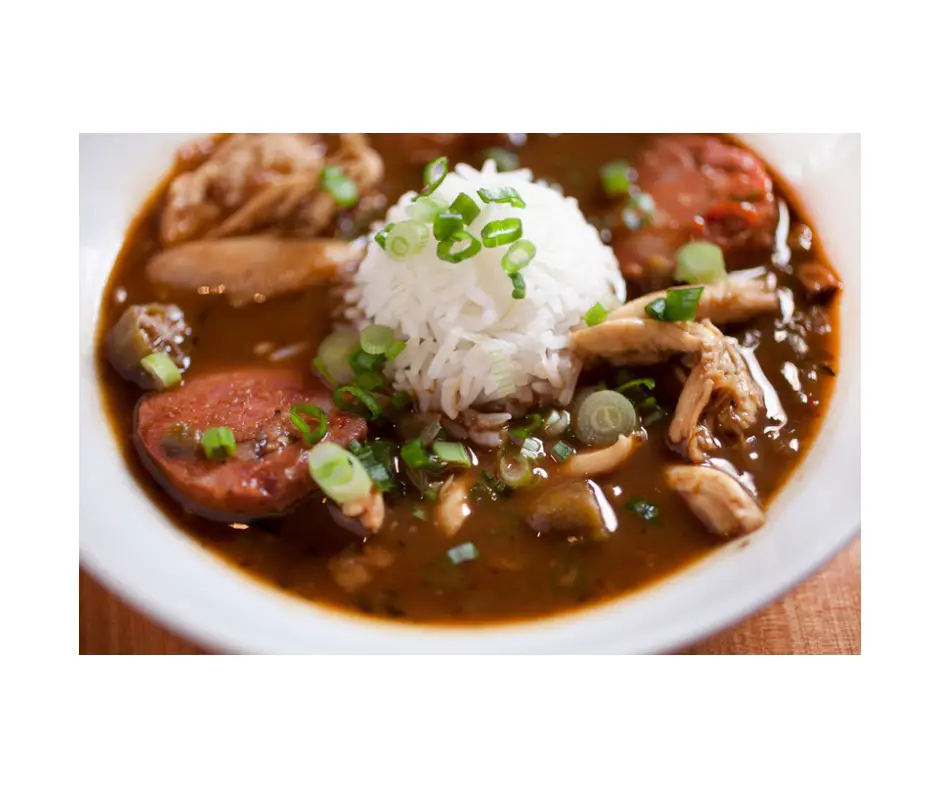Gumbo is an incredible and a fundamental pillar of Louisiana’s food culture.
Constructed from a diverse array of components like roux, choice cuts of meat, select seafood, nutritious vegetables, and invigorating spices — what exactly elevates gumbo from merely good to truly extraordinary?
Opinions on this crucial matter are as varied as the ingredients that go into the pot.
But in this article, I’ll try my best to outline some of the key ingredients that play a critical role in making the successful gumbo.

What Are The Secret Ingredients To Making A Good Gumbo?
It appears that everyone has their own secret when it comes to making a bowl of delicious gumbo.
Some may argue it’s all about a dark colored roux, while others swear by the use of Rotel or chicken stock.
For me, some of the things I’ve found really really useful when making gumbo is slow cooking of the stock, marinating the chicken before using it and serving the gumbo cold or even better, as next day gumbo.
Also, using an assortment of flavors such as fish sauce, chilli powder, dried shrimp and fresh sausage, alongside smoked sausage can really make a difference, depending on your palate.
If you want more in your gumbo, throw in boiled eggs and bay leaves.
Make sure to not leave the Cajun seasoning out too, it infuses that traditional Southern flavor!
I was speaking to a group of my friends the other day and while some of them swore by smoked turkey necks, others stood firmly in their belief that cubes of lightly smoked duck add in a smoky depth that no one should ever want to miss.
In Facebook polls, a lot of people were team okra – chopped or puréed to bring in that classic gumbo essence.
Some say they added garlic for depth and vinegar for balance with its tangy notes.
But there’s one contribution that really took me aback.
“Take time to brew your gumbo; after all, great flavors are coaxed out slowly”.
True! It’s very true, especially when you realize that there isn’t a right way to make gumbo (although there’s a wrong way!)
What Is Real Gumbo Made Of?
At its core, a deeply flavored stock forms the backbone of any gumbo.
This tantalizing broth can be made from meat, poultry, seafood or even vegetables, giving each pot its own signature taste.
Protein is integral to gumbo’s mouth-watering appeal.
Whether it’s tender chicken, zesty sausage, delicious ham or a medley of succulent seafood such as crawfish, crab, shrimp or oysters; each brings its contribution to the symphony of flavor that defines gumbo.
Thickening agents like roux (a hearty mix of fat and flour), okra or filé powder are also critical portion.
The roux imparts color and a rich bready depth while okra offers not only textural intrigue but also an earthy grassy note.
Yes, okra can be slimy – that’s why most cooks prefer frying it off in oil ahead of time.
Filé powder, ground from sassafras leaves adds an intriguing woodsy aroma while contributing to the desired thickness.
The holy trinity in Creole cooking – celery, bell peppers and onions – are no less than foundational to gumbo.
These are critical for building on the complex flavors of gumbo!
And to finish off this artwork: seasonings!
Good doses of salt provide balance while black pepper and cayenne add layers of warmth with hints of heat.
Herbs like bay leaves and thyme evoke comforting homey feelings while garlic infuses every spoonful with moreish intensity.
What Is The Most Important Part Of Gumbo?
The Roux: More Than Just Flour And Fat
Roux might just sound like flour and fat cooked together but it’s so much more than that when it comes to gumbo.
This dynamic duo forms the basis for hundreds of classic recipes, contributing not only savoriness but also thickening our beloved soup.
Not all rouxs are created equal though; in gumbo preparation, the darker the roux, the deeper the flavor.
Rich Broth: The heart of Gumbo
Every bowl of gumbo starts with a hearty broth. Be it chicken stock, seafood broth or even vegetable bouillon – this is where our gumbo gets its depth. It sets up an inviting stage for other ingredients to perform their flavorful magic.
Gumbo’s Protein Power: The Meat
Whether it’s shrimp from the Gulf Coast, succulent chicken or smoky Andouille sausage- meat adds contrasting textures and enriches the flavor profile of every spoonful.
The Holy Trinity
As sacred as its name suggests in Southern cuisine – bell pepper, onion and celery- these three veggies work harmoniously together to provide an aromatic backbone that enhances but never overshadows other components.
Okra
While not always included in every recipe, okra has its fair sway amongst gumbo enthusiasts. Known for its slightly earthy yet sweet taste and notably viscous texture when cooked down; many vouch for its definitive role in authentic gumbo making process.
What Makes Gumbo Thicker?
Firstly, we have okra.
Though love-or-hate-it for some due to its slimy texture, okra is actually one of gumbo’s main thickeners.
Originally brought to the southern United States from Africa, the stickiness in these little green pods comes into play when they are cooked and they release a gel that thickens whatever they’re cooked with.
Next up on the thickening game is filé powder.
Also known as ground sassafras leaves, filé powder is traditionally used by the Choctaw Indians and lends not only thickening properties but also an earthy flavor profile to the gumbo. It’s added after the gumbo has finished cooking just before serving for maximum effect.
Now let’s talk about roux.
This classic French technique is made simply by cooking fat and flour together until a smooth paste forms. When added to soups or stews like gumbo, this paste gently thickens the liquid, adding both richness and body.
And while not traditional, cornstarch and cornmeal can also be used as last minute thickeners for gumbo.
These work their magic by absorbing liquid quickly and expanding to create a thicker base.
What Are The Rules Of Gumbo?
A Brown Roux
Gumbo should always begin with a brown roux. Anything other than that is a big no!
Be careful when making a brown roux though, as it could easily become bitter if not stirred constantly and cooked properly.
The Goo-Free Okra
Okra’s notorious sliminess can be off-putting, that’s why you should fry the sliced okra before adding it into your gumbo. It’ll still thicken the soup and then add texture in an entirely different way!
Holy Trinity
A staple in Louisiana cooking, “holy trinity” refers to bell peppers, celery, and onion. These three ingredients are essential in achieving that quintessential Creole touch.
Rich Broth
Your broth should be as rich as possible – think chicken stock heightened with smoked meats or seafood shells.
Slow Cooker for a Slow Cook
Patience pays off when you’re making gumbo. Slow and steady wins the race here: let your meats simmer leisurely until tender before adding them into your well-cooked roux. And from there, cook everything slowly before you finally serve!
Cajun Seasoning
Authentic Cajun spices bring everything together; a little cayenne pepper, paprika, black pepper and garlic powder goes a long way in enhancing this rich dish’s character.
Rice on the Side: It’s Tradition
Lastly but integral nonetheless – don’t forget the rice! Serving gumbo over long grain rice is not just tradition—it’s simply delicious!
What Should Good Gumbo Taste Like?
Gumbo is more than just a thick soup; it’s an explosion of flavors that instantly sets your taste buds on a journey through the culinary traditions of Louisiana.
Typical gumbo should capture your senses with its deep, complex flavors stemming from the roux base, lavish Cajun spices and various meats or seafood thrown into the mix.
Then texture
The texture is another aspect that sets gumbo apart from other stews. The best gumbo should have a perfectly balanced thickness – not too watery where the ingredients lose their distinct identities, yet not overly gloopy to mask the subtleties.
